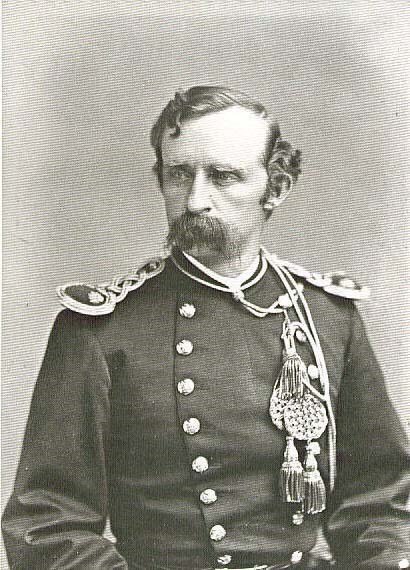
George Armstrong Custer was born in New Rumley, Ohio on December 5, 1839. Custer entered West Point in the fall of 1857. He graduated last in a class of 34 in June of 1861. Custer was present at the first battle of Bull Run in July 1861. Initially Custer was assigned staff duty with the Army of the Potomac. He soon distinguished himself as a man quick to volunteer and easily relied upon. In November of 1862, Custer was introduced to Elizabeth "Libbie" Bacon, the daughter of a judge. Libbie's father, Judge Daniel Bacon, did not approve of his daughter courting someone beneath her station. Nevertheless, the two soon began to court writing letters to one another frequently. In the two years since the war had begun, Custer had been promoted several times to the rank of Brigadier General of Volunteers, and put in command of the Michigan Cavalry Brigade. Libbie's father began to cool his objections to the young couple and in February 1864, the two were married in Monroe, Michigan. In 1866, when the U.S. 7th Cavalry Regiment was created at Fort Riley, Kansas, Custer was promoted to the position of Lt. Colonel of the regiment. The first Colonel of the 7th was Col. Andrew Smith, (1866-1869) and the second Colonel was Col. Samuel Sturgis (1869-1886). Col. Smith and Col. Sturgis were usually on detached service, which placed Custer in command of the Regiment. In 1867, serving under General Winfield Hancock, Custer would see his first real experience in the west, a campaign to enter into peace negotiations with the Southern Cheyennes and Kiowas along the Arkansas River. Hancock's men and Custer set out "to confer with them to ascertain if they want to fight, in which case he [Hancock] will indulge them." While he scarcely saw combat during his Kansas/Colorado campaign, Custer had begun to learn the nuances of Indian fighting. At the end of the campaign, he was placed under arrest and charged with absence without leave from his command, conduct to the prejudice of good order and military discipline, and ordering deserters shot without trial and refusing them medical attention. The court-martial found him guilty of all charges and he was sentenced to one year of suspension from rank without pay. Custer went to Monroe where he would stay for more than a year. In 1868, the U.S. Army prepared a winter campaign in response to Cheyenne raids along the Arkansas valley. Custer, now reinstated, commanded the 7th for the campaign which culminated with the Battle of the Washita on November 27th, 1868. In 1873, the 7th was charged with protecting the Northern Pacific Railroad Survey as it moved along the Yellowstone investigating sites to lay rail. The Lakota, among other tribes, took issue with the construction of the railroad and began attacking survey sites regularly. The following summer of 1874, the 7th was sent to survey the Lakota's Black Hills and charged with finding a proper site for a fort to be built. Along for the expedition, were two professional miners. During the expedition, gold was discovered and accompanying journalists quickly sent word back east, and a new gold rush was on. By late 1875, information had become public that high ranking officials in Washington were involved in a scandal that involved the selling of exclusive trading rights at forts and posts along the upper Missouri region. The licenses needed to trade at military forts were issued by the Secretary of War, William Belknap. In March and April of 1876, Custer testified before a congressional committee that Secretary Belknap was involved in the graft. In addition, Custer's testimony attached President Grant's own brother Orvil to the corruption. This put Custer in a precarious situation with the Commander in Chief, who was presently overseeing the final planning stages of an offensive on non-treaty Lakotas and Cheyennes for the upcoming spring. Custer was eventually allowed to command his 7th Cavalry for the upcoming campaign. In the spring of 1876, the U.S. Army launched a three-part campaign with an objective to force non-treaty Lakota and Cheyenne onto the Great Sioux Reservation. The 7th Cavalry with more than 600 men came from Fort Abraham Lincoln, Dakota Territory. General George Crook with 1,300 men came from Fort Fetterman, Wyoming Territory, and Colonel John Gibbon led a 400-man force from Fort Ellis, Montana Territory. On the morning of June 25th, based on intelligence suggesting that the Lakotas and Cheyennes were about to flee, Custer ordered his 7th Cavalry to attack. By the end of the day, 263 soldiers and civilians, including all five companies riding with Custer and Custer himself, as well as approximately 80 Lakotas and Cheyennes lay dead. On July 4, the 100th birthday of the United States the country would receive word that Custer had been killed and his force defeated. |
Last updated: July 3, 2025
